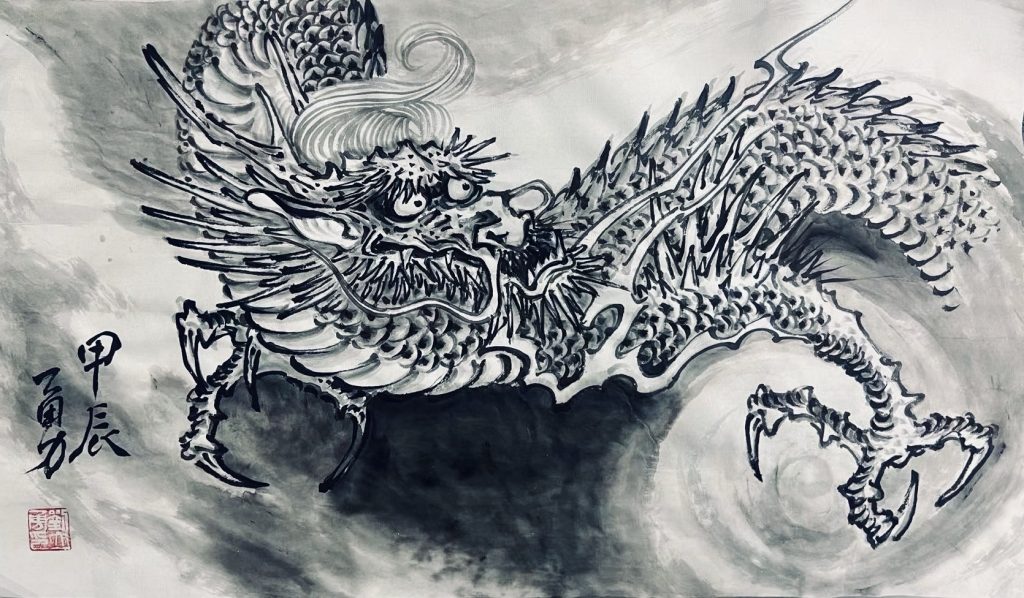
The Chinese New Year or Lunar Festival or Spring Festival is one of the largest cultural events in the world. It is estimated that over two billion people will be involved in celebrations of one form or another. There will be public holidays not just in China but also across Asia. Of course there will be festival activities across the globe, including events for us to join in most major British cities. Already many signs of the imminent festival are in place here in Beijing, especially the ever present lanterns, shining splendid and scarlet from buildings and lamp posts, golden tassels catching the January sun. In Blogs over the next few weeks I will share some of the flavours of festival, but before everything begins, let’s make sure we know what this festival is all about.
We can start with the question, why is the Chinese New Year different from the western version? The answer is the difference between a solar calendar based on movements of the sun and a lunar calendar based on the passages of the moon. The western, solar calendar is called the Gregorian calendar and has a fixed date for New Year – January 1st. The traditional Chinese calendar is based on the moon. A new lunar month starts when the moon moves into a straight line with the earth and the sun. The first day of the festival begins on the New Moon sometime each year between January 21st and February 20th. The holiday and festival lasts 16 days from New Year’s Eve to the 15th day of the New Year which also happens to be the Lantern Festival. In 2024, Lunar New Year starts Saturday, Feb. 10 and ends Saturday, Feb. 24.
In 1912, the government decided to abolish Chinese New Year and the lunar calendar, instead opting to adopt the Gregorian calendar and make January 1 the official start of the new year.This new policy was unpopular, so a compromise was reached: both calendar systems were kept, with the Gregorian calendar being used in government, factory, school and other organisational settings, while the lunar calendar is used for traditional festivals. In 1949, Chinese New Year was renamed the ‘Spring Festival’, and was listed as a nationwide public holiday.
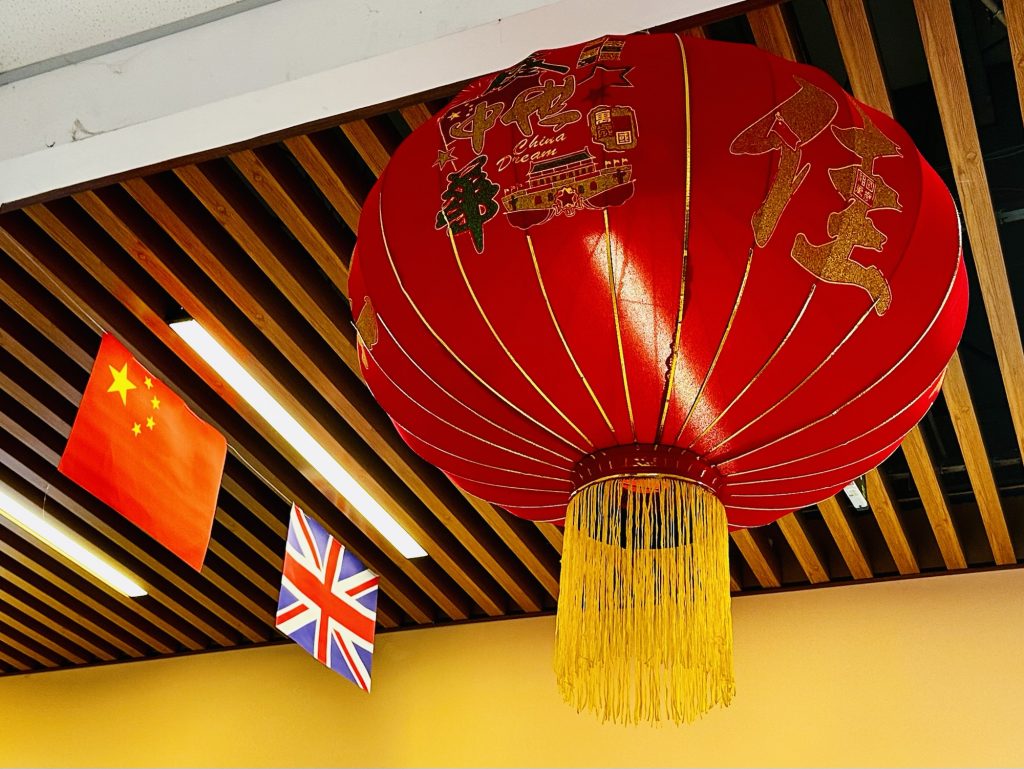
We are all fascinated by the culture and customs of the New Year Festival, but before we dive into what makes this Chinese celebration unique, let’s take a moment to reflect on the threads of connection and similarity. The most obvious is of course that both celebrate the renewal of a new year. Surely the origins of both festivals lie in the agricultural year, a shared sense of joy that the worst of winter is over and warmer days lie ahead. At the heart of both British and Chinese celebrations we find feasting. The famous British Christmas dinner parallels the Family Reunion meal which is the highlight of Chinese New Year for many.
It’s not just the fact of feasting, it’s the act of family reunion that I think is the deepest cultural connection. A few years ago I was lucky enough to spend the new year days themselves with a Chinese family and the amount of eating and drinking were exactly like an English Christmas and so too was the feeling of family warmth. Could it be the family gathering is also an ancestral memory of needing to keep everyone together under the protection of a family roof to survive the hardships of winter and get everyone safely through to Spring?
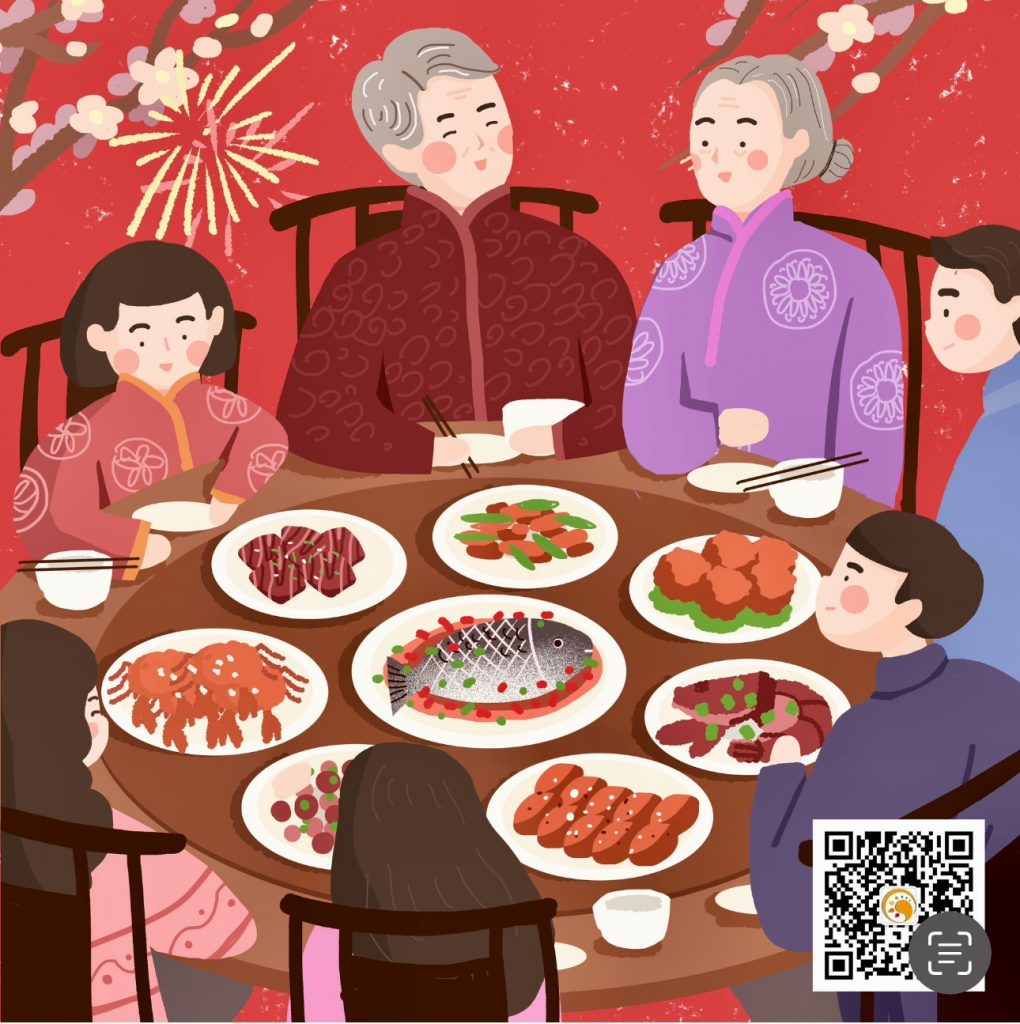
Now we’ve cultivated our shared roots, let’s turn to the distinctive Chinese characteristics. I think most of us are familiar with the customs of the festival – the colour red, the lanterns, the firecrackers, the dancing lions. What we might be less aware of is the symbolism of all of the various aspects of New Year. Actually the symbolism can mostly be traced back to a single legend – the story of a monster called Nian. It’s a great story for children to read in detail, but I’ll just give the main points here.
“ Once upon a time in ancient China there lived a monster called Nian. Nian lived in the depths of the sea and only came out once a year, on New Year’s Eve to devour whatever it could, including people. The local people developed the habit of fleeing into the mountains for safety before Nian arrived every year. One particular year everyone in Peach Blossom village had fled except for an aged grandma living at the end of a lane. As the evening approached, and the time when Nian would appear, an old beggar wandered into the village, with a silver beard, a walking stick and a bag in his hand. The grandmother came out to greet him. She offered him food and advised him to leave immediately. He said, ‘If you can let me shelter in your house tonight, I’ll stop this Nian forever’. The grandmother agreed. When darkness fell Nian roared into the village. He sensed something was not quite right. At the end of the alleyway, the grandmother’s house was brightly lit up, with red paper stuck on the doors. He screeched in anger. He hated lights. He hated the colour red even more. Bellowing, Nian charged at Grandmother’s house but suddenly came to a halt. There were loud explosions which the monster found terrifying. And then the final straw. An old man burst out of grandmother’s house, all dressed in red, howling with laughter and throwing firecrackers in bamboo sticks. It was all too much for the monster who turned and fled, never to return again.”
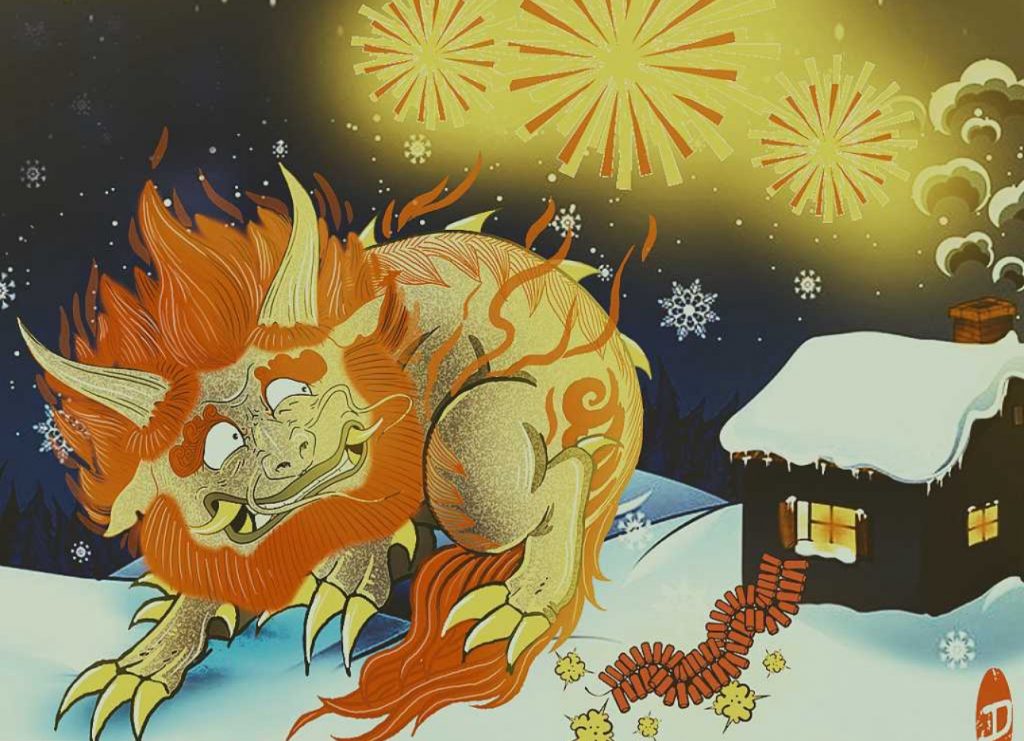
I’m sure the symbolism of many of the things you will see and hear at any New Year festival event is now much, much clearer. The tradition of dragon or lion dances emerged in the Qing Dynasty (1644-1912) growing out of folk entertainments The dragon is well-known as a symbol of wealth, power and vitality. Lions are mythical creatures in China because no lions actually live there. Lions are believed to have the power to drive away evil spirits. In fact you will find carved stone lions at the doorways of traditional houses all over China. A dragon or lion dance is sure to drive away any lurking evil that might want to ruin your new year luck! Of course this year is the Year of the Dragon, an idea I’ll discuss in more detail in another Blog.
We can’t leave the colour red without talking about one of the most popular parts of the festival, especially for children. One of the most eagerly anticipated New Year customs is the giving of ‘hong bao’ or ‘red packets’. A red packet is a small red envelope in which an amount of notes are wrapped to be given as a new year gift. Hong bao are traditionally given by parents to children and by younger people to show respect to their elders. However as I know from my workplace hong bao are also used by employers to show appreciation for workers. Hong bao are not exclusive to New Year, but they are extremely popular at this time of year. The point is not the value of the gift, but the symbolic luck which the money brings, although this is not the sentiment I’ve heard from my colleagues!
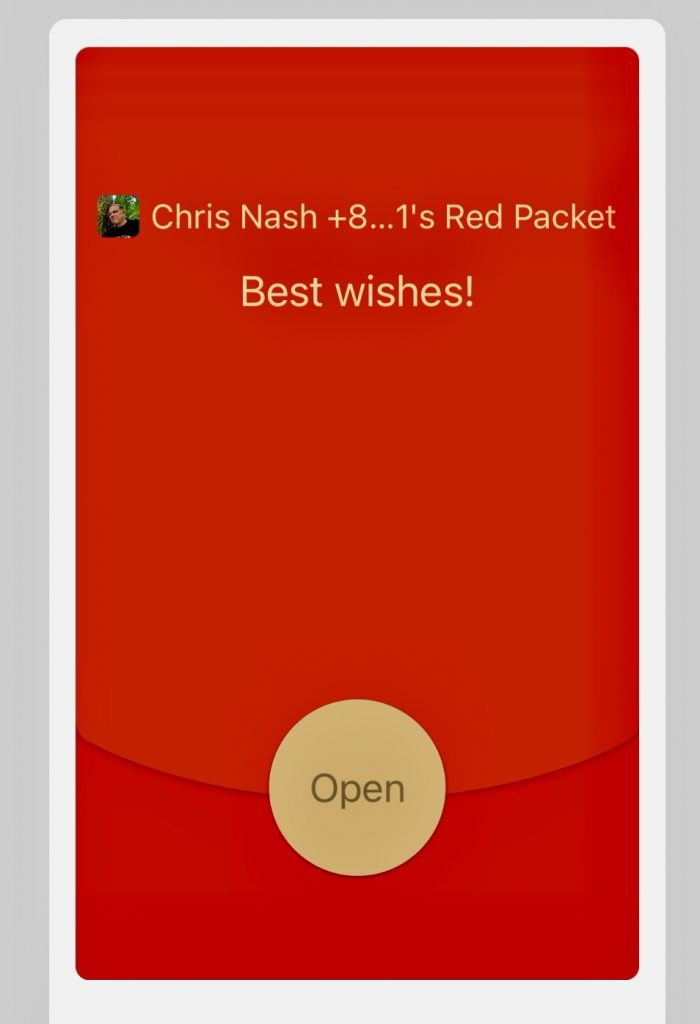
Let’s finish by discussing the heart of the New Year for most Chinese families – the return to your hometown. The New Year is the occasion for one of the largest migrations on the planet as millions of city living Chinese return to their roots. Tomorrow morning (Saturday 27th January) I will join an estimated 143,000 passengers at Beijing West Railway Station starting journeys home all over the country. In my case this is to the remote south-west province of Yunnan, sadly not my actual home in China, but certainly my spiritual home here. China Railway Beijing Group is projected to handle 39.13 million passenger trips during the period, up 14.1 percent compared with the same period of 2019. The travel peak before the Spring Festival will be on February 7, with 1.32 million passenger trips expected to be made. The return peak will be on Feb 25, with 1.35 million passenger trips projected. Altogether it is estimated the holiday will see 9 billion passenger trips. Staggering!
For the last few weeks in school I’ve felt the anticipation amongst my colleagues as they gossip about going , who they’re going to see, what gifts they will take and family activities that will take place.
There are loose connections with British culture I think. There’s an echo of the excitement in Britain before Christmas when people begin to talk about travelling home to see their families. But this doesn’t capture the almost spiritual feeling that accompanies ‘home town’ in Chinese lives. Many Chinese families still have a direct and living connection to roots in towns and villages outside of the cities. Urbanisation is not a completed process as in the UK but a part of living experience. As recently as 1975 only a quarter of the Chinese population lived in cities. As of 2022 this figure had increased to 63%. By comparison this figure in Britain is 84%. The majority of my teaching colleagues are first generation city dwellers with families ‘back home’ in the provinces around Beijing – Liaoning to the north, Shandong to the south or Hebei – the province which curls around Beijing. Of course going home for the holiday is about being reunited with family with all of the traditional Confucian values involved. But I think that in the face of the pressures of urbanisation, it’s also a form of ‘pilgrimage’, a re-connection with your own roots and a re-connection with an authentic Chinese identity.
The significance of this part of New Year can be seen from the amazing success of a 2020 film called ‘我和我的家乡’, ‘My People, My Homeland’ which altogether made 433.2 million dollars. The film consists of five short stories, each created by a different director and each narrative telling a bitter sweet tale about what has been lost in city life and what can be rediscovered in returning to your hometown. If you want to share the flavour of the hometown migration I’d recommend adding this movie to your Chinese New Year celebrations. There’s a popular Chinese expression – 美不美家乡水 – měi bù měi jiāxiāng shuǐ – whether it’s sweet or bitter, water from your hometown is the best. This movie comes as close as anything I know to expressing this feeling.
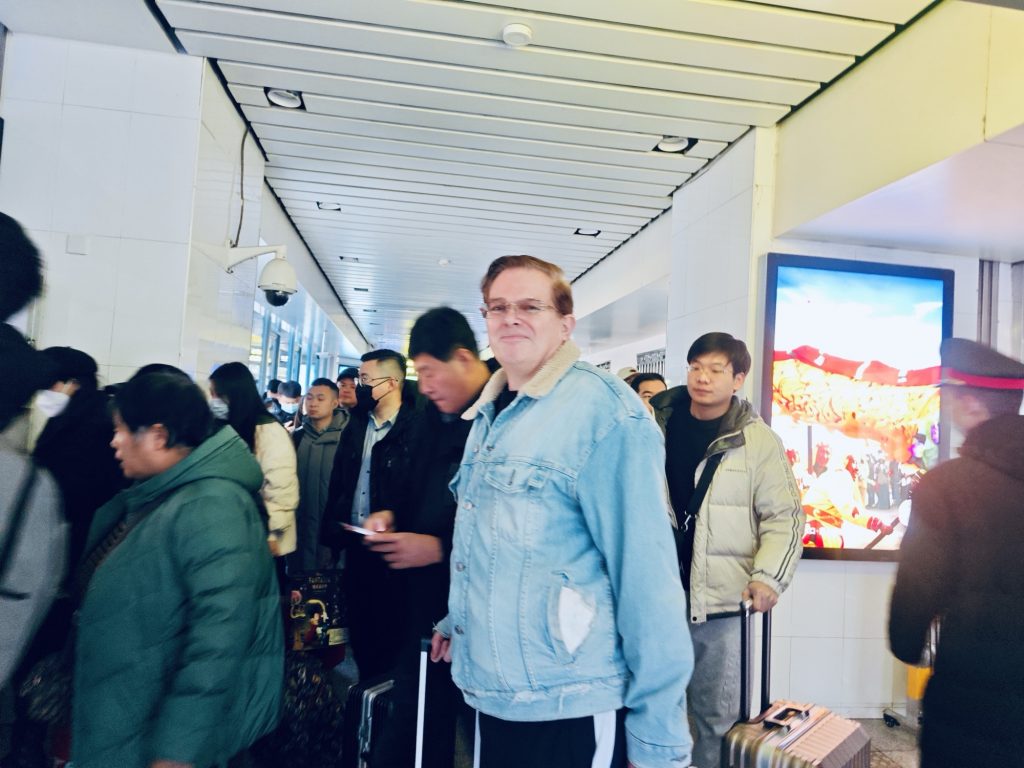
How can you feel closer to Chinese New Year in Britain? Well one thing you could do is to hang bright red scrolls of calligraphy couplets next to your door. This is a very common festival custom all over China. In Chinese they are called ‘Chunlian 春联’. There are three parts to a chunlian. The First Line or Upper Scroll is called a Shanglian 上联|上聯. Shàng lián is the first line of the couplet, traditionally placed on the right side of the door. It is written in vertical columns from top to bottom. It usually has 5, 7, 9 or 11 Chinese characters. The Shanglian typically conveys blessings or good wishes for the New Year. The second is the Lower Scroll or Xialian 下聯|下聯. This is placed on the left side of the door. Like the Shanglian, it is also written in vertical columns. The Xialian often complements the Shanglian and completes the couplet with a response or continuation of the message. The third part is the Horizontal Scroll or Hengpi 横批 (Héng pī). The Hengpi is a shorter phrase (usually 4 characters) that is placed horizontally above the doorframe, connecting and summarising the meaning of the couplet.
Here is an example of all three parts of a complete chunlian.
Shanglian : 迎新春事事如意 (yíng xīn chūn shì shì rú yì)
English: May everything go as you wish in welcoming the Spring Festival.
Xialian : 接洪福步步高升 (jiē hóng fú bù bù gāo shēng)
English: May good fortune come your way, and may each step bring you higher and higher.
Hengpi : 好事临门 (hǎo shì lín mén)
English: Good things come to your door.
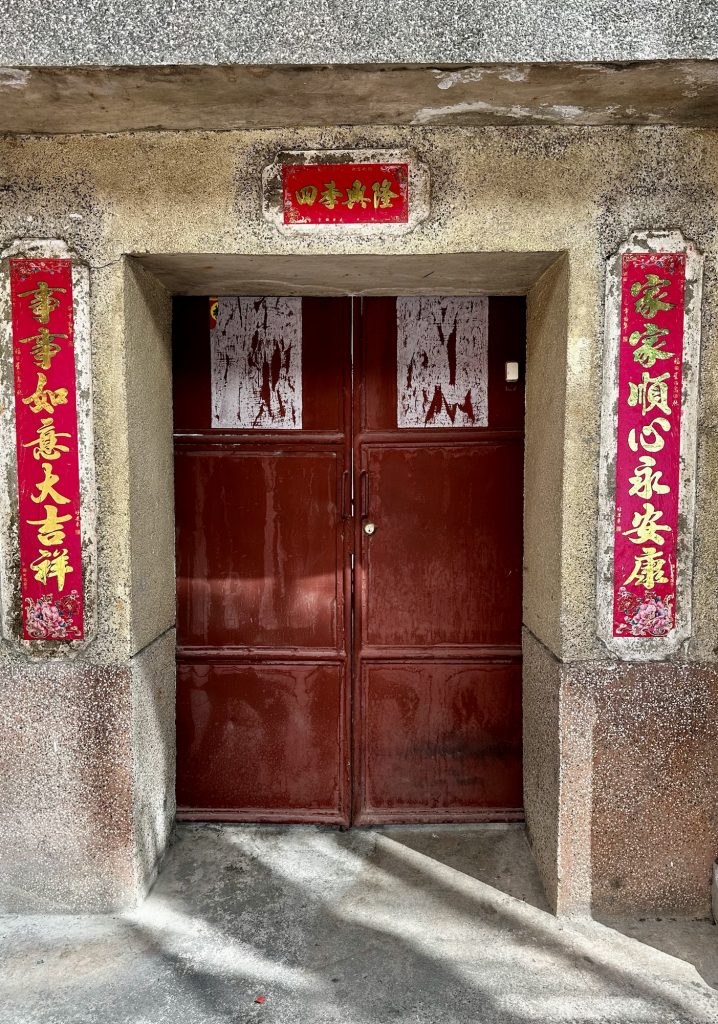
This Spring Festival, may good things come to all our doors!